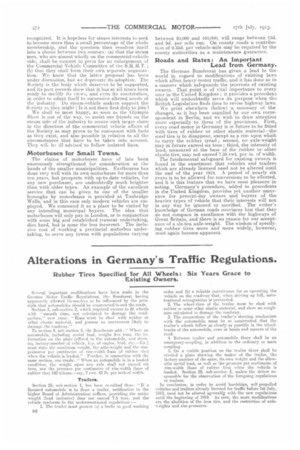Alterations in Germany's Traffic Regulations.
Page 2

If you've noticed an error in this article please click here to report it so we can fix it.
Rubber Tires Specified for All Wheels : Six Years Grace to Existing Owners,
Several important modifications have been made in the German Motor Traffic Regulations, the Bundesrat having apparently allowed themselves to be influenced by the principle that automobiles should be constructed to suit the roads. Section 3, sub-section 2, which required owners to fit wheels with " smooth rims, not calculated to damage the roadsurface," now runs: " Rims must be shod with rubber or other elastic material, and possess no unevenness likely to damage the roadway."
To section 4, sub-section 5, the Bundesrat add : "Where an automobile, including useful load, weighs five tons, the .information ott the plate [affixed to the automobile, and showing factory-number of vehicle, h.p. of engine, lead, etc.—En.] must state the maximum weight, the axle-weight and the rimpressures per centimetre of rim-width (base of rubber tire) when the vehicle is loaded." Further, in connection with the same section, one reads: " When an automobile is in a loaded condition, the weight upon any axle shall not exceed six tons, nor the pressure per centimetre of rim-width (base of rubber tire) 150 kiloms.—say, 7 cwt. 43 lb. per ineh of width.
Trailers.
Section 25, sub-section 1, has been re-edited thus: " If a licensed automobile is to draw a trailer, notification to the higher Board of Administration suffices, providing the entire weight (load inclusive) does not exceed 7.5 tons, and the vehicle conforms to the undermentioned regulations :1. The trailer must possess (a) a brake in good working D2 order and Oa) a reliable contrivance for so operating the vehicle on the roadway that, when driving up hill, unintentional retrogression is prevented. 2. The wheel-rims of the trailer must be shod with rubber or some other elastic material, and show no roughness calculated to damage the roadway. 3. The connections of the trailer's steering mechanism with the automobile must be so constructed that the trailer's wheels follow as closely as possible in the wheeltracks of the automobile, even at bends and corners of the road.
4. Between trailer and antomobile there shall be an emergency-coupling, in addition to the ordinary or main co opting. 5. On a visible position on the trailer there shall be riveted a plate showing the maker of the trailer, the factory-number of the same, its own weight and the allowable useful load, as well as the pressure per centimetre of rim-width (base of rubber tire) when the vehicle is loaded. Section 25, sub-section 3, makes the driver responsible for the observation of the foregoing regulations re trailers.
To conclusion, in order to avoid hardships, self-propelled vehicles and trailers already licensed for traffic before 1st July, 1913, need not be altered agreeably with the new regulations until the beginning of 1919. As seen, the main modifications are the abolition of the iron tire, and the restriction -of axleweights and rim-pressures.














































